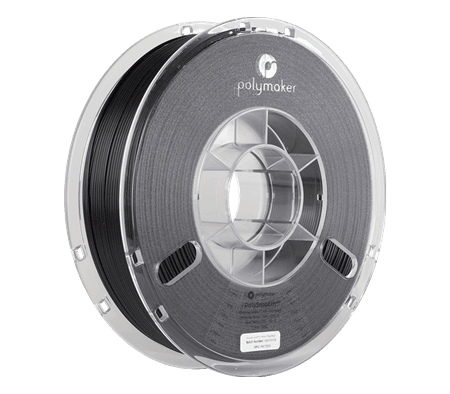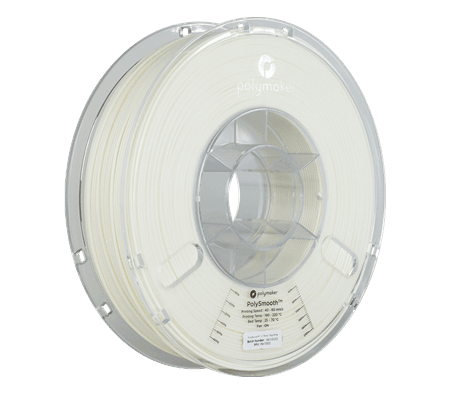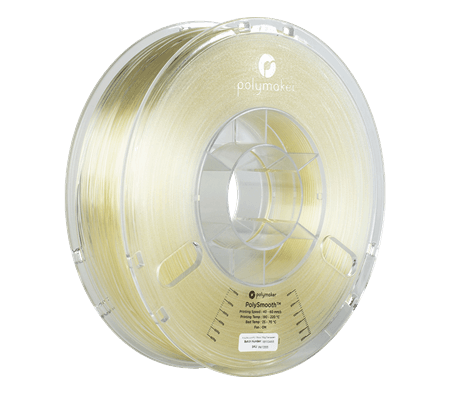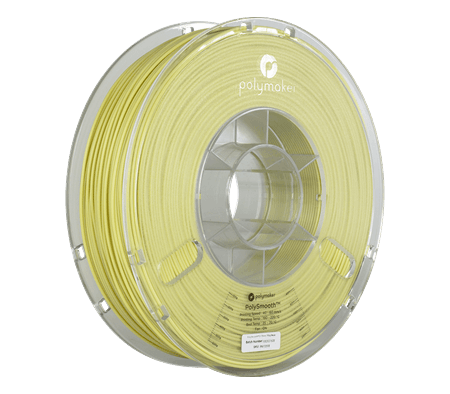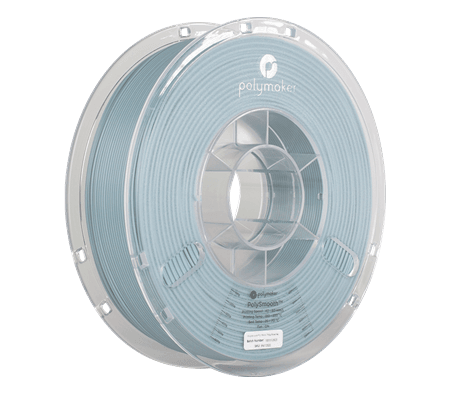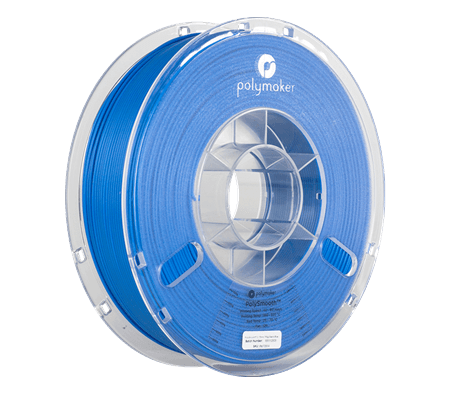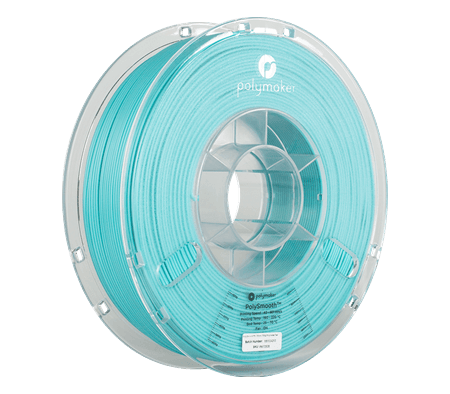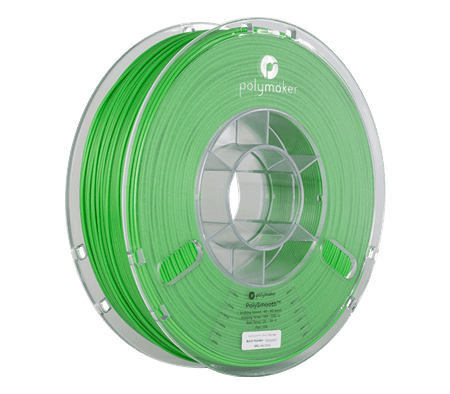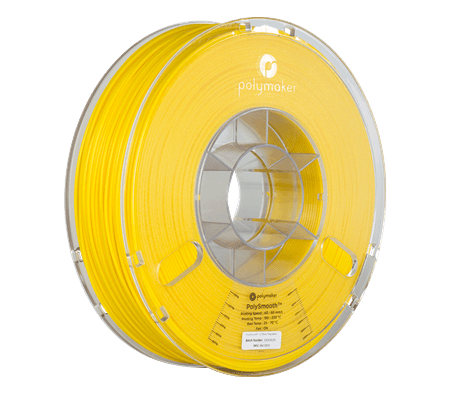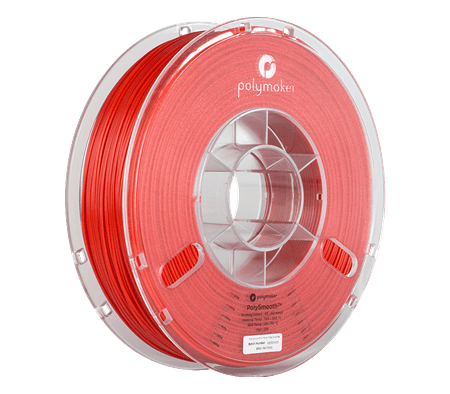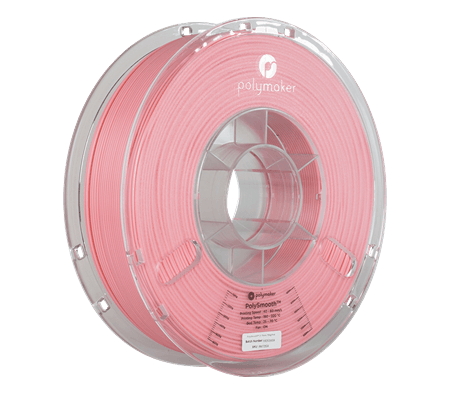Same Day Dispatch
Description
Optimised for easy layer line removal and stronger than PLA & PETG / Compatible with Polymakers Polysher™
- High quality Polymaker PVB-based filament
- Formulated for hands-free post processing with isopropyl alcohol.
- Easy-to-print with PLA-like settings.
- Improved sanding capability compared to regular PLA.
- Consistent colour and tolerance (1.75mm diameter +/- 0.03mm)

PolySmooth™ is a unique, easy-to-print filament designed for hands-free post processing. The surface can be smoothed with alcohol to achieve layer free models using the Polysher™.
We recommend that this material be used with the PolyBox™ and to keep it at dry conditions (relative humidity of 15% or less) at all times to maintain the best printing results.
Features
- Layer-Free™ - Layer-Free™ technology involves exposing a 3D printed part to an aerosol of micro-sized alcohol droplets, generated by a rapidly vibrating, perforated membrane called the nebuliser. The aerosol will then be adsorbed by the surface of the 3D printed part and render it smooth with a glossy surface.
- Effortless Post-processing - The first 3D printable filament engineered for post-processing. Polymaker developed PolySmooth™ to work alongside the Polysher™ (sold separately) providing the solution to dramatically improve the surface quality of 3D printed objects.
- Balanced Mechanical Properties - PolySmooth™ features well balanced mechanical properties, outperforming ABS and PLA on many attributes, making it an ideal material for everyday 3D printing.
- Easy-to-print - PolySmooth™ is compatible with most 3D printers, printing under similar conditions to regular PLA. No heated bed required but can be used for best results (up to 70°C). Polymaker have also optimised PolySmooth™ to allow easy removal of support.
Printing Settings
| Nozzle Temperature | 190°C - 220°C |
|---|---|
| Build Plate Temperature | 40°C - 70°C |
| Build Surface Material | Works well with Glass |
| Build Surface Treatment | Apply PVA glue to the build surface to improve adhesion. |
| Enclosure |
Not required but useful to protect from drafts and maintain a stable printing environment. If enclosed, we strongly recommend to keep a door or lid open to prevent environment from getting too hot. |
| Cooling Fan | ON |
| Printing Speed | 40 mm/s - 60 mm/s |
| Retraction | The ideal retraction settings vary from printer to printer and depend on the hot end. The following settings have been a good starting point for many machines. Direct Drive: Retraction distance of 1mm with retraction speed of 20mm/s Bowden: Retraction distance of 3mm with retraction speed of 40mm/s |
| Recommended Support Material |
Dual Extrusion: |
The above are printing recommendations based on 0.4 mm nozzle. Please note ideal printing conditions may vary depending on your 3D printer setup. For high speed 3D printers, make sure to increase your extrusion temperature in order to use higher printing speeds.
The most notable difference between PLA and PVB-based materials are moisture absorption. We recommend taking additional care to keep PVB-based materials dry and protect them from moisture (during storage and printing) to ensure the best printing results. See 'storage & drying' details below.
For other tips printing PolySmooth™ PVB contact us!
Specification
| Net Weight | 750g |
|---|---|
| Material Type | PVB |
| Density | 1.1 (g/cm3 at 21.5˚C) |
Compatibility
PolySmooth™ PVB has been engineered with compatibility in mind to print excellently on a wide range of 3D printers. If your printer suffers from heat creep and has difficulty printing some brands of PLA or Silk PLA due to jamming, your hot-end may suffer from heat creep.
PVB 3D printing materials work best in set ups where the filament guide system is smooth and as no harsh bends.
Of course with thousands of unique 3d printer models on the market, we can't guarantee each filament type will work with every 3D printer. Slicer experience and setting adjustment is always required to get the most out of a material. Before jumping into an ambitious project we always recommend printing some known calibration tests to build or make adjustments to the filament profile.
Technical Data
All testing specimens were printed under the following conditions: Nozzle Temperature = 220˚C, build plate temperature = 60˚C, infil = 100%, cooling fan = ON
All specimens were conditioned at room temperature for 24h prior to testing.
THERMAL PROPERTIES
| Value | Testing Method | |
| Glass Transition | 70°C | DSC, 10°C/min |
| Heat Deflection Temperature |
0.45MPa - 68°C |
ISO 75 |
| Vicat Softening Temperature | 70°C | ISO 306, GB/T 1633 |
MECHANICAL PROPERTIES
| Value | Testing Method | |
| Youngs Modulus (X-Y) |
2,092 MPa | ISO 527, GB/T 1040 |
| Tensile Strength (X-Y) |
44.1 MPa | ISO 527, GB/T 1040 |
| Tensile Strength (Z) | 18.4 MPa | ISO 527, GB/T 1040 |
| Elongation at break (X-Y) | 3.4% | ISO 527, GB/T 1040 |
| Bending Modulus (X-Y) | 2062 MPa | ISO 178, GB/T 9341 |
| Bending Strength (X-Y) |
76.2 MPa | ISO 178, GB/T 9341 |
| Charpy Impact Strength (X-Y) |
9.2 kJ/m2 | ISO 179, GB/T 1043 |
We have full MDS and technical data sheets for PolySmooth™ PVB and all other Polymaker products. Contact us to enquire!
The typical values presented in Polymakers data sheet are intended for reference and comparison purposes only. Due to the nature of 3D printing they should not be used for design specifications or quality control purposes.
STORAGE & DRYING
All plastics are hygroscopic meaning they absorb moisture from the air which can affect printing quality and strength of printed parts. How quickly this absorption occurs depends on the material and your environment. Polymakers PolySmooth™ PVB filaments are dried and packaged in a vacuum sealed bag with desiccant to ensure the best printing quality. When not in use PolySmooth™ PVB should be stored away from sunlight and sealed in the packaged resealable bag.
Although filaments can be dried, drying will speed up the aging process of the plastic making it more brittle over time. Preventing the filament from absorbing moisture in the first place is the best solution to keep your filament working to its maximum potential. For long term storage we highly recommend storing in a sealed container with dry desiccant that reduces the relative humidity to 10-20% RH.
In-house we manage our filaments with Polymakers PolyDryer™ which keep offers best-in-class sealing to protect filaments from absorbing moisture
If you hear popping sounds and notice that the surface quality of your print is uneven or the colour is not consistent, this is a likely indicator that the filament has absorbed too much moisture. Spools of PolySmooth™ PVB can be dried with Polymaker PolyDryer™ using power level 2. Alternatively if you have a convection oven that is accurate at low temperatures, users can dry filament in a preheated convection oven at 50˚C for up to 12 hours. Results may vary depending on the accuracy of your oven so please be conservative. For more information about filament drying please read our user guide.
FAQ
Q: Is PolySmooth™ a PLA filament?
A: PolySmooth™ is neither PLA nor ABS; it is the first 3D printing material based on PVB (polyvinyl butyral), formulated/designed specifically to combine "smoothability" and excellent printing characteristics.
Q: Will Polymakers Layer-free™ technology improve the quality of my 3D prints?
A: Polymakers Layer-free™ technology is designed to improve the surface quality of 3D prints while maintaining details including textures and dimensions The best post-processing results will be achieved when PolySmooth™ has been printed with fine layer heights and no defects. If a part has been printed with defects or a rough surface finish, these defects will be maintained in the same way that details are preserved. In these cases users willing to the detail of their print can over-polish the part to soften the impact of the defect.
Q: Can PolySmooth™ be printed at large scales without warping?
A: PolySmooth™ offers very similar dimensional stability to PLA and PETG and can certainly be printed at large scales without warping. When printing large objects we recommend a consistent room temperature and setting your heated bed to 70˚C. Please note while PolySmooth™ doesn't warp in most situations, printing in a cold environment or with poor first layer adhesion can cause any material to warp.
Q: What support materials can I use with this product?
A: Polymaker’s PolyDissolve™ S1 filament is the recommended support filament for PolySmooth™. If your 3D printer is not equipped for multi-material, self-support can be used.
Q: Should I rewind this filament if I want to use it with a different spool?
A: We strongly advise against tampering with the product by rewinding. See our article for full details about the risks. All Polymaker filaments are wound with tension but without strain. Rewinding completely rearranges the curvature of the winding and this strain over time can cause most plastics to catastrophically break. If for some reason your printer is locked into fitting less than standard sized spools, there may be safe printable adaptors or external mounting solutions available.
Don't know where to start? Or which filament will suit your application? We have a broad range of support options including telephone support. Contact us today!
| Filament | |
| Diameter | 1.75mm |
| Spool Weight | 750g |
PolySmooth™ is a first of its kind material specifically engineered for hands free post-processing with isopropyl alcohol! The formula of PolySmooth™ is incredibly unique and engineered to combine excellent surface quality, functional mechanical performance and similar printing conditions to PLA.
- Specifically engineered for hands free post-processing with multiple smoothing options. Safe and easy with Polymakers Polysher™.
- With balanced mechanical properties, PolySmooth™ is a fantastic choice for everyday projects.
- Formulated to print with similar requirements and conditions to PLA.
- Exhibits fantastic dimensional stability for large 3d printing projects.
- Solubility with alcohol enables users to easily join 3D prints together.

3D printed fashion from Laura Jonas
Laura Jonas is a Czech company creating unique fashion items using PolySmooth™ and the Polysher™ to achieve a finish that is aesthetically pleasing for their jewellery range. Combining glossy plastic parts with materials more traditionally found in jewellery making, Laura Jonas has managed to create a look that is unique and beautiful.
Martin Jonas – Head Designer says “I love working with Polysmooth™ and the Polysher™, I used to spend a lot of time sanding and buffing my 3D prints to get them to the industry standard surface finish. Polysmooth™ has completely removed this process, now I can print our accessories and get repeatable results in the Polysher™ with no extra effort.”

OpenRC car designed by Daniel Norée and printed in Coral Red, Black and White PolySmooth™
It is no surprise that PolySmooth™ has become a popular choice for everyday printing projects, providing an easy to work with material that can be easily joined or post-processed. Available in a diverse range of colours, PolySmooth™ offers a safe alternative for users interested in post-processing their projects either manually or automatically. While materials like ABS and ASA can be chemically smoothed with their own solvent (acetone): the vapour smoothing process of ABS is hard to control and these materials have more printing requirements to consider.

Unpolished PolySmooth™ on the left and polished PolySmooth™ on the right.
PolySmooth™ offers users many post-processing possibilities. First and formost PolySmooth™ is designed to work effortlessly with Polymakers Polysher™ to deliver users an easier and safer process to remove layer-lines. The technology behind PolySmooth™ involves exposing the part to an aerosol of alcohol micro-droplets which absorb onto the surface of the PolySmooth™ print. With the Polysher™, exposure time can be easily controlled to preserve features and details.
The alcohol solubility of PolySmooth™ also offers the potential to post-process large projects manually. When manually post-processing large items. it is recommend to work in a well ventilated and dust free environment.

To provide a solution which can be used to produce real products, mechanical properties are just as important as surface quality. In addition to balanced mechanical performance, Polymakers Layer-free™ technology also offers some interesting benefits with improvements in impact resistance after polishing. It is not because of any chemical change of the material, but due simply to the fact that the surface is now smooth and free of defects. So the “ridges and valleys” from the layers prior to polishing can often act as stress concentrators, and are usually where the damage (in the form of cracks) initiates; by eliminating the layers the part becomes more damage-resistant and tougher.

The polishability and surface of PolySmooth™ offers many post-printing possibilities.
For painters and hobbyists, PolySmooth™ offers a unique solution to smooth parts without spending many hours sanding and filing. Once the surface has been polished, PolySmooth™ adheres well to a variety of paints including: Acrylic, Oil, Eggshell, Emulsion, Watercolor, Cellulose (<50% thinners, sprayed with an airbrush at 7psi) and Powder.
For users who require a smooth matte surface finish, simply coat the model with a matte spray paint after polishing.

With the ability to produce smooth 3D objects, PolySmooth™ lends itself well to hydrographic printing applications. Traditional hydrographic printing has been limited to repetitive patterns as it is almost impossible to line up models with details on the print. Now using software developed by Prof. Zhou's lab, Prof. Zhou has been able to turn a 3D surface into a 2D map and using a conventional 2D printer and a PVA film; controlling with a very high degree of accuracy exactly where the print will go onto the surface.
The smooth, layer-free surface (after polishing) greatly facilitates the hydrographic printing process and the PolySmooth™ bonds strongly to the ink, without any need of surface treatment prior to hydrographic printing. By combining the two technologies one can easily produce high-quality, full-colour products with desktop 3D printing!
PolySmooth™ also allows for easy support removal and clean up, the majority of 3D printers currently on the market are single extrusion machines, as a consequence, complex geometries that require support must use the same support material as the build material. In some cases, this can cause issues as the support can leave scarring on the interface surface where the support meets the model. Compared to other materials PolySmooth™ supports can be removed relatively easily and scarring that is caused by the support material can often times be remove once the part has been polished.
Users who own a dual extrusion 3D printer can also print PolySmooth™ with Polymakers PolyDissolve™ S1. PolyDissolve™ S1 is a dedicated support material engineered to deliver water dissolvable supports with perfect interfacing and improved part surface quality. PolyDissolve™ S1 is compatible with a wide range of material types and Polymaker filaments.

• Orders ship out of Townsville, QLD, Australia at 1530.
• Active on Instagram - Tag us or DM us!
• Watch what we are up to on our YouTube Channel!
• Join our Facebook Page for updates and RSFPV news.
• GST Registered.
• Gifts with every order!
• Veteran Owned and Operated
• Defence and Service discounts - Apply Here
• 3D Printing and Custom design – Inquire Here.
• Visit us at our Store and have a yarn.
• Sponsor of Townsville FPVR, Next Level FPV
and the Australian Army Drone Racing Team.
• FPV Drone service, support and repairs.
• Earn points for every $1 spent.
• Buy now and pay later with Zippay, Afterpay, Humm and Laybuy.

